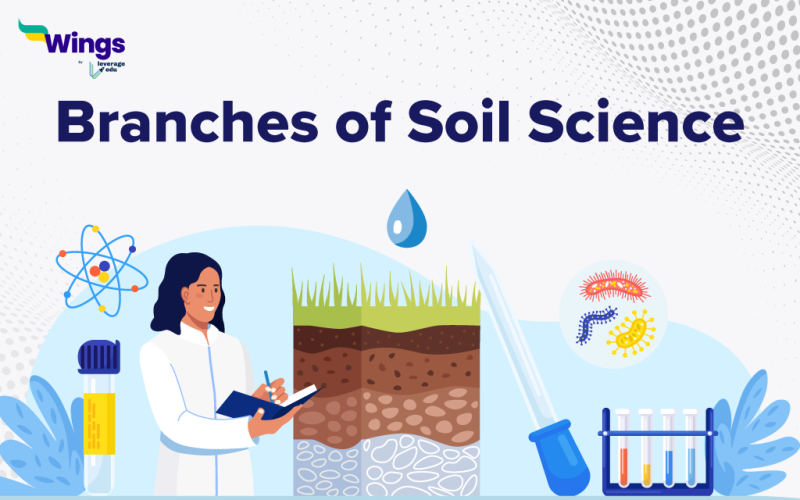Soil science is an interdisciplinary domain that encompasses the examination of soil as a vital natural resource and its intricate connections with the environment. Its influence extends significantly to agriculture, environmental stewardship, land-use strategies, and a diverse range of other fields.
This field delves into various aspects, including the formation and dispersion of soil, as well as the intricate interplay of its biological, chemical, and physical properties and processes. These interactions play a crucial role in informing decisions related to environmental management, industry practices, and the promotion of sustainable development. Throughout this blog, we will explore the distinct branches of soil science, offering clear definitions and illustrative examples to underscore their importance in our understanding of the natural world.
Also Read: BSc Agriculture Subjects
This Blog Includes:
What is Soil Science?
Soil science encompasses the comprehensive examination of soil properties on the Earth’s surface, covering aspects such as soil classification, formation, and mapping. Additionally, it delves into the practical application of soil and its management. This field is divided into two main branches: pedology and edaphology.
Pedology focuses on the chemical processes underlying soil formation, its categorization, and its physical characteristics. Conversely, edaphology centers on the study of how soil influences living organisms, particularly plants. Soil science draws expertise from a diverse range of professionals, including microbiologists, archaeologists, chemists, engineers, and physical geographers, all of whom contribute to advancing our understanding of this crucial natural resource.
Also Read: How To Become an Environmentalist?
Branches of Soil Science
Soil constitutes a crucial component of the pedosphere, which covers the Earth’s crust. The primary branches of soil science, as mentioned earlier, encompass both edaphology and pedology, each addressing the physical, chemical, and biological aspects of soil.
Below are the main branches of soil science:
Soil Physics
Soil physics examines the physical properties of soil, including texture, structure, density, and water retention. It also delves into the movement of water and air through soil pores. Soil physicists use mathematical models to predict how soil properties impact plant growth and water availability.
Example: In precision agriculture, soil physics plays a key role in determining optimal irrigation practices, ensuring water is distributed evenly across a field.
Soil Formation
The process of soil formation, known as pedogenesis, initiates from the “parent material” (rocks) located either below or above ground level. Various climatic conditions significantly influence the rate and process of soil formation. Over time, rocks weather away, carried by wind, water flow, or glaciers, eventually settling to form distinct layers. Rainfall serves as a crucial agent, eroding soil particles through processes like erosion.
Additionally, flowing rivers transport soil particles. Organisms such as earthworms contribute to soil formation by creating pores within the Earth’s crust and aiding in decomposition.
Pedology is the study of soil formation, classification, and mapping. It seeks to understand the processes that shape soil profiles, including weathering, mineral deposition, and organic matter accumulation. Pedologists classify soils into various categories based on their properties and characteristics. For instance, Ultisols are typically found in humid tropical regions and are characterized by their high clay content and acidity.
Example: Pedologists use field surveys and laboratory analyses to create soil maps that aid in land-use planning, crop selection, and conservation practices.
Soil Chemistry
Soil chemistry focuses on the chemical composition and reactions that occur within soils. It explores nutrient availability, pH levels, ion exchange, and the interactions between soil minerals and organic matter. Soil chemists study elements like nitrogen, phosphorus, and potassium and their influence on plant growth.
Example: Understanding the pH levels of soil is crucial for selecting suitable crops. For instance, blueberries thrive in acidic soils with a pH range of 4.5 to 5.5.
Soil Microbiology
Soil microbiology examines the diverse community of microorganisms living within soil. This branch studies bacteria, fungi, algae, and other microbes and their roles in nutrient cycling, decomposition, and disease suppression. Understanding soil microbiology is crucial for sustainable agriculture and environmental management.
Example: Mycorrhizal fungi form mutualistic relationships with plant roots, aiding in nutrient uptake and enhancing plant growth.
Soil Management and Land Use Planning
Soil management involves applying scientific knowledge to optimize land use for various purposes, such as agriculture, forestry, urban development, and conservation. It considers factors like soil type, climate, and vegetation cover to make informed decisions about land utilization.
Example: Urban planners use soil information to design sustainable cities, considering factors like soil drainage for effective stormwater management.
The branches of soil science collectively contribute to our understanding of soil as a vital natural resource. From studying its formation and chemistry to optimizing fertility and conservation practices, soil science plays a pivotal role in agriculture and environmental sustainability.
By delving into these various branches, scientists and practitioners work together to ensure the responsible management of this critical component of our ecosystem.
Also Read: What is Food Web?
FAQs
Ans. The field of soil science encompasses two main branches: pedology and edaphology. Pedology involves the study of soil in its natural environment, while edaphology focuses on soil in relation to its various applications and uses.
Ans. Soil refers to the loose material covering the majority of land surfaces. It is composed of both inorganic particles and organic matter.
Ans. Soil can be categorized into three main types according to its texture: sand, silt, and clay. Nevertheless, the proportions of these components may differ, leading to more complex soil types like loamy sand, sandy clay, silty clay, and so forth.
We hope you find this useful. For more such content, subscribe to Leverage Edu!
 One app for all your study abroad needs
One app for all your study abroad needs















 45,000+ students trusted us with their dreams. Take the first step today!
45,000+ students trusted us with their dreams. Take the first step today!
